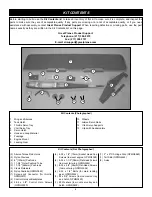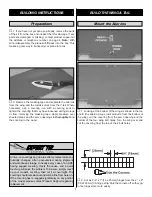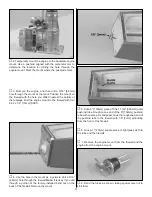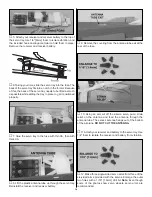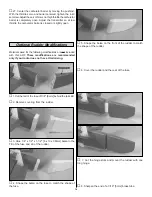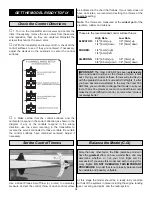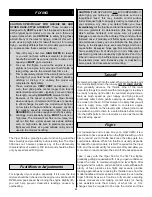
❏
1. Use a felt-tip pen or 1/8" [2mm] wide tape to accurately
mark the C.G. on the bottom of the wing on both sides of the
fuselage. The C.G. is located 3" [75mm] back from the
leading edge of the wing.
❏
2. With the wing attached to the fuselage, all parts of the
model installed including the fuel tank hatch (ready-to-fly)
and an empty fuel tank, place the model as shown above on
a Great Planes CG Machine, or lift it at the balance point
you marked.
❏
3. If the tail drops, the model is “tail heavy” and the
battery pack and/or receiver must be shifted forward or
weight must be added to the nose to balance. If the nose
drops, the model is “nose heavy” and the battery pack
and/or receiver must be shifted aft or weight must be added
to the tail to balance. If possible, relocate the battery pack
and receiver to minimize or eliminate any additional ballast
required. If additional weight is required, nose weight may
be easily added by using a “spinner weight” (GPMQ4645 for
the 1 oz. weight, or GPMQ4646 for the 2 oz. weight). If spinner
weight is not practical or is not enough, use Great Planes
(GPMQ4485) “stick-on” lead. A good place to add stick-on
nose weight is in the fuel tank compartment. If there is not
sufficient space, then the firewall is an excellent mounting
location. Begin by placing incrementally increasing amounts
of weight on the firewall until the model balances. Once you
have determined the amount of weight required, it can be
permanently attached. If required, tail weight may be added
by cutting open the bottom of the fuse and gluing it
permanently inside. Glue the fuel tank hatch in place if nose
weight is needed.
Note: Do not rely upon the adhesive on the back of the lead
weight to permanently hold it in place. Over time, fuel and
exhaust residue may soften the adhesive and cause the
weight to fall off. Use #2 sheet metal screws, RTV silicone
or epoxy to permanently hold the weight in place.
❏
4. IMPORTANT: If you found it necessary to add any
weight, recheck the C.G. after the weight has been installed.
❏
5. REMEMBER: Now that the model is balanced, glue
the tank hatch in place.
❏
1. With the wing level, have an assistant help you lift the
model by the engine propeller shaft and the bottom of the
fuse under the TE of the fin. Do this several times.
❏
2. If one wing always drops when you lift the model, it
means that side is heavy. Balance the airplane by adding
weight to the other wing tip. An airplane that has been
laterally balanced will track better in loops and other
maneuvers.
No matter if you fly at an AMA sanctioned R/C club site or if
you fly somewhere on your own, you should always have
your name, address, telephone number and AMA number
on or inside your model. It is required at all AMA R/C club
flying sites and AMA sanctioned flying events. Fill out the
identification tag on page 23 and place it on or inside
your model.
Follow the battery charging instructions that came with your
radio control system to charge the batteries. You should
always charge your transmitter and receiver batteries the
night before you go flying, and at other times as
recommended by the radio manufacturer.
Charge the Batteries
Identify Your Model
PREFLIGHT
Balance the Model Laterally
This is where your model should balance for the first
flights. Later, you may wish to experiment by shifting the
C.G. up to 2-5/8" [67mm] forward or 3-3/8" [86mm] back
to change the flying characteristics. Moving the C.G.
forward may improve the smoothness and stability, but
the model may then require more speed for takeoff and
make it more difficult to slow for landing. Moving the C.G.
aft makes the model more maneuverable, but could also
cause it to become too difficult to control. In any case,
start at the recommended balance point and do not at
any time balance the model outside the specified range.
19


